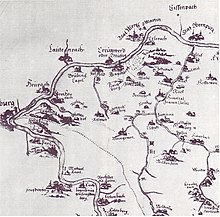Schippach (Elsenfeld)
|
Schippach
Elsenfeld market
Coordinates: 49 ° 49 ′ 40 ″ N , 9 ° 12 ′ 9 ″ E
|
|
|---|---|
| Height : | 144 m above sea level NHN |
| Area : | 3.68 km² |
| Residents : | 666 (Jan 3, 2017) |
| Population density : | 181 inhabitants / km² |
| Incorporation : | July 1, 1971 |
| Postal code : | 63820 |
| Area code : | 06022 |
Schippach is a district of the Elsenfeld market in the Miltenberg district in Bavaria .
geography
The parish village of Schippach is located on the left bank of the Elsava at 144 m above sea level. NHN . The district road MIL 32 from Rück to Streit and the Franconian Marienweg run through the village . Schippach has grown together structurally with Rück and is only separated by the Elsava. The two districts of Elsenfeld taken together have always been unofficially referred to as the Rück-Schippach. The left Elsava tributary Veilchenbach flows through Schippach .
On the former Obernburg-Elsenfeld-Heimbuchenthal railway line , a cycling and hiking trail runs through the Schippach district.
history
Band ceramic ( Bronze Age ) grave finds testify to a settlement in the area around Schippach that dates back more than 5000 years. By cairns at Eichelsbach a relatively dense population for the time around 1600-700 can v. Prove. However, there was probably no continuous settlement in pre-Franconian times. The actual historical period only began here in the 6th century.
Schippach was first mentioned in a document in 1233, when the Counts of Rieneck expanded the ownership of the Himmelthal monastery to include lands around Schippach. In the middle of the 13th century, Schippach was entered in the “Koppelfutter-Directory” of the sovereign, archbishop and elector of Mainz . At the end of the Old Kingdom , Schippach was part of the Prodzelten and Klingenberg winery of the Kurmainzer Obererzstift. Mayor and Zöller was Anton Mott.
In 1803 Schippach was in the Principality of Aschaffenburg of the Kurerzkanzlerisches Staat, from 1806 of the Primatialstaats Karl Theodor von Dalberg . From 1810 Schippach belonged as Mairie to the Klingenberg district mairie of the Klingenberg sub-prefecture of the Aschaffenburg department of the Grand Duchy of Frankfurt and had 122 inhabitants with 26 fireplaces. Maire, Accisor and Landzöller was Anton Klug; his adjunct Alois Kern. In 1814, Schippach and the sub-prefecture of Klingenberg passed to the Crown of Bavaria and from October 1, 1814 it belonged to the administrative area of the Klingenberg Regional Court . In the course of administrative reform in Bavaria was the Gemeindeedikt the formerly independent municipality Schippach of the 1818th Through the amalgamation of the older district courts Klingenberg and Obernburg, the Obernburg District Office was formed in 1862 , on whose administrative area Schippach was now together with Rück.
On January 1, 1939, the uniform imperial designation Landkreis was introduced. Thus the district office became the district of Obernburg am Main .
On July 1, 1971, the previously independent community of Schippach with the communities of Rück and Eichelsbach voluntarily joined the Elsenfeld market. On July 1, 1972, the district of Obernburg am Main was dissolved as part of the regional reform in Bavaria. The Elsenfeld market was added to the Miltenberg district.
Buildings
In 1752 the Catholic parish church of St. Antonius of Padua was built as a hall church with an aligned three-sided choir, gable roof with eight-sided slated roof turrets and onion hood, plastered masonry with stone edges and frames.
In 1915, initiated by a "Eucharistic covenant of love" founded by the Schippach virgin and prophet Barbara Weigand, according to Weigand, at the request of Jesus Christ, the construction of a "sacrament church" began, a colossal domed structure which should have been crowned by a golden monstrance . The building project was withdrawn from the church in autumn 1915 due to religious concerns. In the spring of 1916, the police stopped construction. Despite all of Weigand's threatening prophecies, construction was not continued in the decades that followed, also for financial reasons. Numerous hewn stone blocks from this time are still on the site.
It was not until 1960 that the Catholic parish church of St. Pius was built on the foundations of the Sacrament Church according to plans by the Würzburg cathedral master builder Hans Skull in the form of a round building made of interlocking room shells with indirectly illuminated glass fronts and bands of light to the flat, inclined pent roof made of formwork concrete with sandstone cladding.
In 1962, the Catholic parish church of St. Pius was added an octagonal chapel extension in a concrete frame construction with painted glass surface windows and a convent building of the Salvatorian Order (stretched two-storey flat roof building with sandstone-clad ground floor and plastered protruding upper storey).
Personalities
- Barbara Weigand (born December 10, 1845 in Schippach; † March 20, 1943 there) was a Catholic mystic and a seer.
- Arnold Renz SDS, baptized Wilhelm Renz (born January 14, 1911 in Hiltensweiler near Tettnang; † May 17, 1986 in Feldkirch), from 1965 superior of the Salvatorian monastery in Schippach, also looked after the parish of St.-Pius-X. Church and campaigned for the beatification of the seer Barbara Weigand . He carried out the great exorcism more than 60 times on the Klingenberg student Anneliese Michel .
Oddities
The local name for the Schippacher is Rahmensuckler.
Individual evidence
- ↑ Contour lines on the BayernAtlas of the Bavarian State Government ( notes ).
Web links
- Schippach in the location database of the Bayerische Landesbibliothek Online . Bavarian State Library

